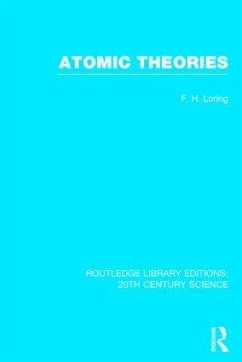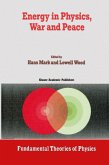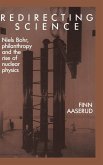F H Loring
Atomic Theories
F H Loring
Atomic Theories
- Gebundenes Buch
- Merkliste
- Auf die Merkliste
- Bewerten Bewerten
- Teilen
- Produkt teilen
- Produkterinnerung
- Produkterinnerung
Summarising the most novel facts and theories which were coming into prominence at the time, particularly those which had not yet been incorporated into standard textbooks, this important work was first published in 1921.
Andere Kunden interessierten sich auch für
![Chernobyl Record Chernobyl Record]() R F MouldChernobyl Record187,99 €
R F MouldChernobyl Record187,99 €![Historical Atlas of Crystallography Historical Atlas of Crystallography]() J. Lima-de-Faria (ed.)Historical Atlas of Crystallography84,99 €
J. Lima-de-Faria (ed.)Historical Atlas of Crystallography84,99 €![Energy in Physics, War and Peace Energy in Physics, War and Peace]() Hans Mark / Lowell Wood (Hgg.)Energy in Physics, War and Peace153,99 €
Hans Mark / Lowell Wood (Hgg.)Energy in Physics, War and Peace153,99 €![Beyond the God Particle Beyond the God Particle]() Leon M LedermanBeyond the God Particle21,99 €
Leon M LedermanBeyond the God Particle21,99 €![Redirecting Science Redirecting Science]() Finn AaserudRedirecting Science118,99 €
Finn AaserudRedirecting Science118,99 €![The Standard Model in a Nutshell The Standard Model in a Nutshell]() Dave GoldbergThe Standard Model in a Nutshell100,99 €
Dave GoldbergThe Standard Model in a Nutshell100,99 €![The Physics of the Manhattan Project The Physics of the Manhattan Project]() Bruce Cameron ReedThe Physics of the Manhattan Project52,99 €
Bruce Cameron ReedThe Physics of the Manhattan Project52,99 €-
-
-
Summarising the most novel facts and theories which were coming into prominence at the time, particularly those which had not yet been incorporated into standard textbooks, this important work was first published in 1921.
Hinweis: Dieser Artikel kann nur an eine deutsche Lieferadresse ausgeliefert werden.
Hinweis: Dieser Artikel kann nur an eine deutsche Lieferadresse ausgeliefert werden.
Produktdetails
- Produktdetails
- Verlag: Taylor & Francis
- Seitenzahl: 232
- Erscheinungstermin: 7. Mai 2014
- Englisch
- Abmessung: 234mm x 156mm x 14mm
- Gewicht: 503g
- ISBN-13: 9781138017368
- ISBN-10: 1138017361
- Artikelnr.: 40050055
- Herstellerkennzeichnung
- Libri GmbH
- Europaallee 1
- 36244 Bad Hersfeld
- gpsr@libri.de
- Verlag: Taylor & Francis
- Seitenzahl: 232
- Erscheinungstermin: 7. Mai 2014
- Englisch
- Abmessung: 234mm x 156mm x 14mm
- Gewicht: 503g
- ISBN-13: 9781138017368
- ISBN-10: 1138017361
- Artikelnr.: 40050055
- Herstellerkennzeichnung
- Libri GmbH
- Europaallee 1
- 36244 Bad Hersfeld
- gpsr@libri.de
Loring, F.H.
Preface. Preface to the Second Edition 1. Introduction: Atomic Theories:
Earlier Views 2. Atomic Weights and Whole-Number Isotopes 3. Electrons and
Atomic Nuclei: Sub-atomic Phenomena 4. Co-ordinating the Electrical
Properties of the Atom 5. K and L Series of Lines by X-ray Analysis 6. A
Note on Crystal Structure 7. Radio-activity and Crystal Structure as Clues
to Atomic Structure 8. Rutherford's Nuclear Theory of the Atom, with
Detailed Experimental Evidence: Supplementary Notes 9. The Quantum Theory
10. The Bohr-Rutherford Atom: Sommerfield's Extension: And Einstein's
Studies of the Stark Effect 11. The Photo-Electric Effect 12. The Zeeman
Effect: Gaseous Ionisation: Ionisation Potentials: and Modern Views
Concerning Radiation 13. The Lewis-Langmuir Atomic Theory: The Octet
Theory: Introduction 14. The Lewis-Langmuir Atomic Theory: The Octet
Theory: Arrangement of Electrons in Atoms and Molecules 15. The Octet
Theory: Being a Continuation from the Preceding Chapter: Ionisation in
Solids and Liquids: Etc. 16. Co-ordinating the Rutherford and
Lewis-Langmuir Theories 17. The Lewis-Langmuir Octet Theory of Valence
Applied to Organic Nitrogen Compounds 18. The Octet Theory as a Clue to
Certain Types of Molecular Instability, and a Few Remarks 19. A Note of
Caution 20. The Possible Complexity of Hydrogen: Its Position in the
Periodic Table 21. The Energy of the Atom: Elements in the Sun and Their
Ionisation: Atomic Energy and Solar Radiation: Sun-Spots, Aurora and
Magnetic Storms: High Pressure Experiments of Sir C.A. Parsons: High
Temperatures 22. Atomic and Molecular Magnitudes Determined by the Brownian
Movement 23. Magnetic Susceptibilities of the Elements: A Geometrical
Representation of Variable Magnitudes: Ferromagnetism and Atomic Structure
24. Sir J.J. Thomson's Views of Mass, Energy and Radiation. Appendices
Earlier Views 2. Atomic Weights and Whole-Number Isotopes 3. Electrons and
Atomic Nuclei: Sub-atomic Phenomena 4. Co-ordinating the Electrical
Properties of the Atom 5. K and L Series of Lines by X-ray Analysis 6. A
Note on Crystal Structure 7. Radio-activity and Crystal Structure as Clues
to Atomic Structure 8. Rutherford's Nuclear Theory of the Atom, with
Detailed Experimental Evidence: Supplementary Notes 9. The Quantum Theory
10. The Bohr-Rutherford Atom: Sommerfield's Extension: And Einstein's
Studies of the Stark Effect 11. The Photo-Electric Effect 12. The Zeeman
Effect: Gaseous Ionisation: Ionisation Potentials: and Modern Views
Concerning Radiation 13. The Lewis-Langmuir Atomic Theory: The Octet
Theory: Introduction 14. The Lewis-Langmuir Atomic Theory: The Octet
Theory: Arrangement of Electrons in Atoms and Molecules 15. The Octet
Theory: Being a Continuation from the Preceding Chapter: Ionisation in
Solids and Liquids: Etc. 16. Co-ordinating the Rutherford and
Lewis-Langmuir Theories 17. The Lewis-Langmuir Octet Theory of Valence
Applied to Organic Nitrogen Compounds 18. The Octet Theory as a Clue to
Certain Types of Molecular Instability, and a Few Remarks 19. A Note of
Caution 20. The Possible Complexity of Hydrogen: Its Position in the
Periodic Table 21. The Energy of the Atom: Elements in the Sun and Their
Ionisation: Atomic Energy and Solar Radiation: Sun-Spots, Aurora and
Magnetic Storms: High Pressure Experiments of Sir C.A. Parsons: High
Temperatures 22. Atomic and Molecular Magnitudes Determined by the Brownian
Movement 23. Magnetic Susceptibilities of the Elements: A Geometrical
Representation of Variable Magnitudes: Ferromagnetism and Atomic Structure
24. Sir J.J. Thomson's Views of Mass, Energy and Radiation. Appendices
Preface. Preface to the Second Edition 1. Introduction: Atomic Theories:
Earlier Views 2. Atomic Weights and Whole-Number Isotopes 3. Electrons and
Atomic Nuclei: Sub-atomic Phenomena 4. Co-ordinating the Electrical
Properties of the Atom 5. K and L Series of Lines by X-ray Analysis 6. A
Note on Crystal Structure 7. Radio-activity and Crystal Structure as Clues
to Atomic Structure 8. Rutherford's Nuclear Theory of the Atom, with
Detailed Experimental Evidence: Supplementary Notes 9. The Quantum Theory
10. The Bohr-Rutherford Atom: Sommerfield's Extension: And Einstein's
Studies of the Stark Effect 11. The Photo-Electric Effect 12. The Zeeman
Effect: Gaseous Ionisation: Ionisation Potentials: and Modern Views
Concerning Radiation 13. The Lewis-Langmuir Atomic Theory: The Octet
Theory: Introduction 14. The Lewis-Langmuir Atomic Theory: The Octet
Theory: Arrangement of Electrons in Atoms and Molecules 15. The Octet
Theory: Being a Continuation from the Preceding Chapter: Ionisation in
Solids and Liquids: Etc. 16. Co-ordinating the Rutherford and
Lewis-Langmuir Theories 17. The Lewis-Langmuir Octet Theory of Valence
Applied to Organic Nitrogen Compounds 18. The Octet Theory as a Clue to
Certain Types of Molecular Instability, and a Few Remarks 19. A Note of
Caution 20. The Possible Complexity of Hydrogen: Its Position in the
Periodic Table 21. The Energy of the Atom: Elements in the Sun and Their
Ionisation: Atomic Energy and Solar Radiation: Sun-Spots, Aurora and
Magnetic Storms: High Pressure Experiments of Sir C.A. Parsons: High
Temperatures 22. Atomic and Molecular Magnitudes Determined by the Brownian
Movement 23. Magnetic Susceptibilities of the Elements: A Geometrical
Representation of Variable Magnitudes: Ferromagnetism and Atomic Structure
24. Sir J.J. Thomson's Views of Mass, Energy and Radiation. Appendices
Earlier Views 2. Atomic Weights and Whole-Number Isotopes 3. Electrons and
Atomic Nuclei: Sub-atomic Phenomena 4. Co-ordinating the Electrical
Properties of the Atom 5. K and L Series of Lines by X-ray Analysis 6. A
Note on Crystal Structure 7. Radio-activity and Crystal Structure as Clues
to Atomic Structure 8. Rutherford's Nuclear Theory of the Atom, with
Detailed Experimental Evidence: Supplementary Notes 9. The Quantum Theory
10. The Bohr-Rutherford Atom: Sommerfield's Extension: And Einstein's
Studies of the Stark Effect 11. The Photo-Electric Effect 12. The Zeeman
Effect: Gaseous Ionisation: Ionisation Potentials: and Modern Views
Concerning Radiation 13. The Lewis-Langmuir Atomic Theory: The Octet
Theory: Introduction 14. The Lewis-Langmuir Atomic Theory: The Octet
Theory: Arrangement of Electrons in Atoms and Molecules 15. The Octet
Theory: Being a Continuation from the Preceding Chapter: Ionisation in
Solids and Liquids: Etc. 16. Co-ordinating the Rutherford and
Lewis-Langmuir Theories 17. The Lewis-Langmuir Octet Theory of Valence
Applied to Organic Nitrogen Compounds 18. The Octet Theory as a Clue to
Certain Types of Molecular Instability, and a Few Remarks 19. A Note of
Caution 20. The Possible Complexity of Hydrogen: Its Position in the
Periodic Table 21. The Energy of the Atom: Elements in the Sun and Their
Ionisation: Atomic Energy and Solar Radiation: Sun-Spots, Aurora and
Magnetic Storms: High Pressure Experiments of Sir C.A. Parsons: High
Temperatures 22. Atomic and Molecular Magnitudes Determined by the Brownian
Movement 23. Magnetic Susceptibilities of the Elements: A Geometrical
Representation of Variable Magnitudes: Ferromagnetism and Atomic Structure
24. Sir J.J. Thomson's Views of Mass, Energy and Radiation. Appendices









